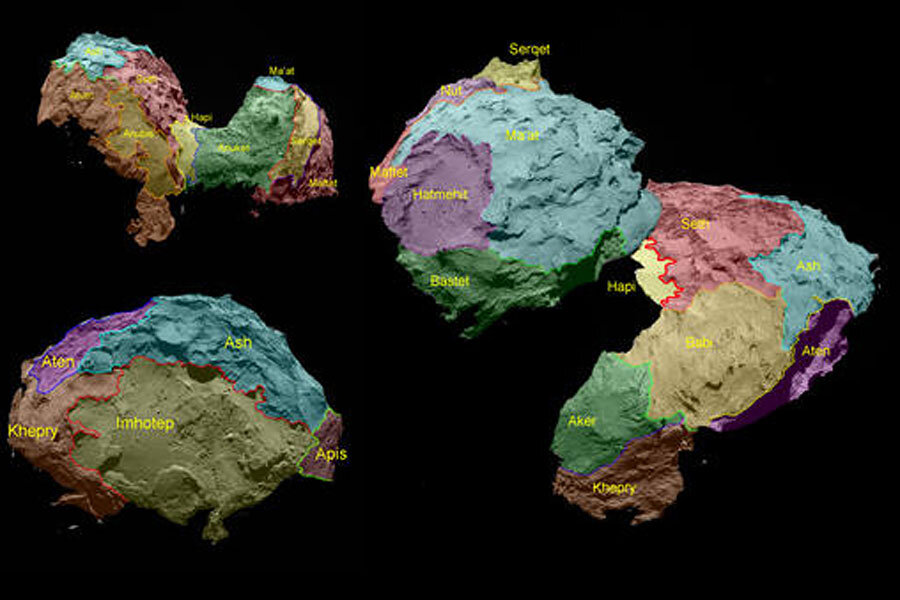Rosetta comet is much weirder than expected, say scientists
Loading...
Sen—Europe's Rosetta spacecraft has made important discoveries about the comet it is orbiting that have surprised scientists busily studying the cosmic wanderer.
Research papers published tonight in the journal Science cast new light on what Comet 67P/Churyumov-Gerasimenko is made of and what happens as it is warmed by the Sun.
The international team of scientists found that the coma, or atmosphere, given off by this warming is much more uneven in its make-up than first appears. The gas emitted varies significantly over time in its amount and consistency.
This tells them that the 6km (4.5 mile) long, rocky head of the comet, known as the nucleus, is formed of a mix of material with varying quantities in different parts, rather than a homogenous collection of ice, dust and rocky particles.
Understanding their make-up is important because comets are leftover remnants from the formation of the Solar System and so hold important clues about the processes that were involved.
Nineteen distinct regions with different types of terrain have been identified and given names of Egyptian deities, in keeping with the theme of the Rosetta mission, to identify them. On some cliffs have been spotted features dubbed goosebumps that could be the lumps of material that originally came together to form the comet.
Dr Stephen Fuselier, of the Southwest Research Institute (SwRI), Texas, is a co-investigator for the Rosetta Orbiter Spectrometer for Ion and Neutral Analysis Double Focusing Mass Spectrometer (ROSINA DFMS) instrument aboard the European Space Agency’s Rosetta probe.
He said in a statement: “From a telescope, images of a comet’s atmosphere suggest that the coma is uniform and does not vary over short periods of hours or days. That’s what we were expecting as we approached the comet.
“It was certainly a surprise when we saw time variations from 200 km away. More surprising was that the composition of the coma was also varying by very large amounts. We’re taught that comets are made mostly of water ice. For this comet, the coma sometimes contains much more carbon dioxide than water vapour.”
Colleague Dr Myrtha Hässig, also of the SwRI, said: “If we would have just seen a steady increase of gases as we closed in on the comet, there would be no question about heterogeneity (an even mix) of the nucleus.
“Instead we saw spikes in water readings, and a few hours later, a spike in carbon dioxide readings. This variation could be a temperature effect or a seasonal effect, or it could point to the possibility of comet migrations in the early Solar System.”
Comet 67P surprised the Rosetta team when they got their first close-up look because it is twin-lobed, which led to it being likened to a rubber duck. Most of the gas is being given off around the comet’s neck, and scientists want to know whether the comet formed from two bodies that collided or wheher a single body has become worn down around its middle by the outgassing.
Astronomers Michael A’Hearn and Dennis Bodewits, of the University of Maryland, are trying to find the answer by studying detailed pictures from Rosetta’s two most powerful cameras, the Optical, Spectroscopic and Infrared Remote Imaging System (OSIRIS).
Professor Emeritus A’Hearn has experience of comet close-ups because he was principal investigator on NASA’s Deep Impact mission that blasted a hole in Comet Tempel I in 2005 to study material inside the nucleus.
He said: “We are trying to see how a comet evolves over time, and also through the course of its orbit. Gaining this detailed time series is what distinguishes Rosetta from other missions, such as Deep Impact.”
Bodewits is closely studying the visible surface of Comet 67P to see how its shape has changed over time, and where there might be located larger deposits of water and ice.
Observations from Earth have long shown that gas and dust given off by comets gets swept away by the pressure of the solar wind, producing occasionally spectacular tails. But, using OSIRIS, Bodewits saw some particles orbiting the comet unaffected by this pressure.
“Because comets have very little gravity, dust and gas flow freely into space. But we were surprised to find a cloud of particles orbiting the comet that are large and heavy enough to defy the Sun’s radiation pressure,” he said.
Another paper in Science, from a NASA team, describes results from an experiment to measure the comet’s temperature beneath its surface by probing the nucleus and the way gas and dust are being produced to form 67P/s coma.
The team based at the Jet Propulsion Laboratory in California has been observing at millimetre wavelengths using NASA’s Microwave Instrument on Rosetta to see how heat is transported within the nucleus.
An early and predictable finding is that water vapour is not being given off evenly but instead is coming mainly from the area of the comet that is in sunlight.
Peter Schloerb, of the University of Massachusetts Amherst, said in a statement: “In our initial results, not surprisingly, we found important day-night and seasonal variations in the temperature of the nucleus.
“It is northern summer now, so the northern latitudes are quite warm, while some southern latitudes are un-illuminated at this time and very cold. We’re the only instrument that can make measurements of this un-illuminated part of the comet, so our measurements are completely unique in that area.”
Related Links:
Rosetta's colour photo show comet is many shades of grey
Rosetta's comet adds to the riddle of Earth's oceans
Philae finds life's building blocks on comet's surface
Original story from Sen. © 2015 Sen TV Limited. All rights reserved. This material may not be published, broadcast, rewritten or redistributed. For more space news visit Sen.com and follow @sen on Twitter.







